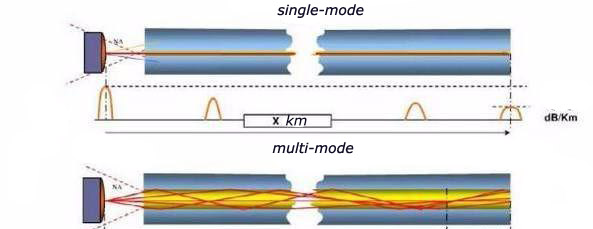In the process of inquiring about Industrial Switches, customers often ask whether they are all-electrical ports or optoelectronic free combination. When it comes to industrial switches with optical ports, single-mode multi-mode, single-fiber dual-fiber, and then What do these mean? The industrial switch manufacturer Houshi Network will give us a brief popularization of science.
The single-mode multi-mode of the industrial switch depends on the optical cable. The single-fiber and dual-fiber refers to one-core optical fiber transmission or two-core optical fiber transmission; Both ends are connected to this core, and both ends use different optical wavelengths, so optical signals can be transmitted in one core.Double fiber is to use two cores, one for sending and one for receiving, one end is for sending and the other end must be inserted into the receiving port, that is, the two ends must be crossed.
Single-mode means that the optical signal propagates through a single channel, and there is only a single propagation path, which is generally used for long-distance transmission, while dual-mode or multi-mode has two or more propagation paths.Multimode is mostly used in networks with relatively low transmission rates and relatively short transmission distances, such as local area networks, etc. Such networks usually have many nodes, many joints, and many detours, and the amount of connectors and couplers is large, and the unit fiber The length uses the characteristics of a large number of light sources.When the user chooses whether to transmit through single-mode or multi-mode, the primary determining factor is the distance that the user needs to transmit.The single-mode transmission has less attenuation, but the transmission speed is also relatively slow, which is suitable for long-distance transmission. Generally, the distance is greater than 5 miles, and single-mode fiber is the best choice. For short-distance transmission, generally less than 5 miles, multimode fiber is the best choice.
Single-mode multi-mode In specific applications, the amount of multi-mode is higher than that of single-mode, mainly in the wiring range below 500m, multi-mode has been able to meet, although the performance is not as good as single-mode.Single-mode applications are used in environments above 500m or in environments with high bandwidth requirements, and most of them are large-scale site applications such as enterprise level.Because the working stability and performance of optical fiber modules are much better than transceivers, in the application environment of single-mode, which has high performance requirements, few companies will use transceivers, but directly replace them with modules. There are fewer manufacturers of analog transceivers, and the price is higher.

The single-fiber and dual-fiber generally have two ports, and the two ports of the dual-fiber are relatively close, respectively marked TX, RX, one for sending and one for receiving, which are designated; the two ports of the single-fiber generally use P1, P2 indicates that the two ports can send and receive separately, that is, one port can be used to complete the sending and receiving, so it is called single fiber.There are two types of fiber optic transceivers: one is single-mode and the other is dual-mode. Just like a highway, if there is only a single-line line, there may be traffic jams. point.
The main difference between single mode and multimode fiber:
The 850nm wavelength region is multi-mode fiber communication; the 1550nm wavelength region is single-mode fiber communication; the 1310nm wavelength region is multi-mode and single-mode; the attenuation at 850nm is larger, but for 2~3MILE (1MILE=1604m) communication more economical.The fiber size is divided into 50μm graded multimode fiber, 62.5μm graded enhanced multimode fiber and 8.3μm mutant single mode fiber according to the fiber diameter. , 9/125μm and other different types.Therefore, the difference between single-mode and multi-mode fiber optic transceivers is the difference between multi-mode fiber and single-mode fiber.
So can single-mode and multi-mode industrial switches replace each other? The answer depends on the transmission distance.Because multi-mode is multi-node and multi-port signal transmission in the working mode, the signal distance transmission is relatively short, but it is more convenient, and the construction of the local intranet is redundant.Single fiber is a single node transmission, so it is suitable for the transmission of long-distance trunk lines and constitutes the construction of a cross-domain local area network.
In short, in automation, communication and intelligent engineering, we often encounter remote control and signal communication, and twisted pair cables cannot meet the need to use optical fibers.The variety of optical fibers is complex, including single-mode, dual-mode, single-core, dual-core, cortical optical fibers, and optical cables. The cost of various materials and applications of optical fibers is different. Only by choosing the most suitable one will the cost be reduced.Therefore, the choice of single-mode and multi-mode industrial switches is an important issue that must be considered. Once used, it will be very troublesome to replace later, and it will also involve wiring and other issues.
Contact: sales
Phone: 18688787693
E-mail: sales@hsindustrialswitch.com
Add: Room 608, Building B,GaoXinQi TEC Park,Baoan District, ShenZhen,China